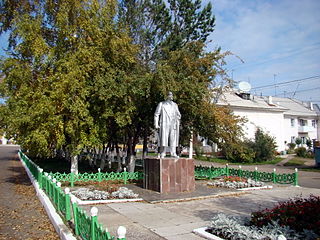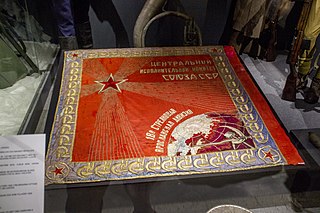
The Battle of Borodino took place near the village of Borodino on 7 September [O.S. 26 August] 1812 during Napoleon's invasion of Russia. The Grande Armée won the battle against the Imperial Russian Army, but failed to gain a decisive victory and suffered tremendous losses. Napoleon fought against General Mikhail Kutuzov, whom the Emperor Alexander I of Russia had appointed to replace Barclay de Tolly on 29 August [O.S. 17 August] 1812 after the Battle of Smolensk. After the Battle of Borodino, Napoleon remained on the battlefield with his army; the Imperial Russian forces retreated in an orderly fashion southwards. Because the Imperial Russian army had weakened the Grande Armée, they allowed the French occupation of Moscow, using scorched earth tactics on their own population to trap Napoleon and his men with their own largest city. The failure of the Grande Armée to completely destroy the Imperial Russian army, and in particular Napoleon's reluctance to deploy his Imperial Guard due to Napoleon's wishes to negotiate with Alexander to make him join against the British, has been widely criticised by historians as a large blunder, as it allowed the Imperial Russian army to continue its retreat into territory increasingly hostile to the French.

Prince Mikhail Illarionovich Golenishchev-Kutuzov-Smolensky was a Field Marshal of the Russian Empire. He served as a military officer and a diplomat under the reign of three Romanov monarchs: Empress Catherine II, and Emperors Paul I and Alexander I. Kutuzov was shot in the head twice while fighting the Turks and survived the serious injuries seemingly against all odds. He defeated Napoleon as commander-in-chief using attrition warfare in the Patriotic war of 1812. Alexander I, the incumbent Tsar during Napoleon's invasion, would write that he would be remembered amongst Europe's most famous commanders and that Russia would never forget his worthiness.

The 250th Infantry Division, better known as the Blue Division, was a unit of volunteers from Francoist Spain operating from 1941 to 1943 within the German Army on the Eastern Front during World War II. It was officially designated the Spanish Volunteer Division by the Spanish Army.

The Battle of Moscow was a military campaign that consisted of two periods of strategically significant fighting on a 600 km (370 mi) sector of the Eastern Front during World War II, between October 1941 and January 1942. The Soviet defensive effort frustrated Hitler's attack on Moscow, the capital and largest city of the Soviet Union. Moscow was one of the primary military and political objectives for Axis forces in their invasion of the Soviet Union.

Borodino is a village in Mozhaysky District of Moscow Oblast, Russia, located 13 kilometers (8.1 mi) west of Mozhaysk.

Vyazma is a town and the administrative center of Vyazemsky District in Smolensk Oblast, Russia, located on the Vyazma River, about halfway between Smolensk, the administrative center of the oblast, and Mozhaysk. Throughout its turbulent history, it defended western approaches to Moscow. Population: 57,101 (2010 Census); 57,545 (2002 Census); 59,022 (1989 Soviet census); 44,000 (1970).

Russian Winter, sometimes personified as "General Frost" or "General Winter", is an aspect of the climate of Russia that has contributed to military failures of several invasions of Russia and the Soviet Union. Mud is a related contributing factor that impairs military maneuvering in Russia and elsewhere, and is sometimes personified as "General Mud". Russians call these muddy conditions rasputitsa, which occur with autumnal rains and spring thaws in Russia and make transport over unimproved roads difficult.
The 3rd Army was a field army of the Red Army during World War II.

The 5th Guards Combined Arms Red Banner Order of Zhukov Army is a Russian Ground Forces formation in the Eastern Military District.

The 4th Panzer Army, operating as Panzer Group 4 from its formation on 15 February 1941 to 1 January 1942, was a German panzer formation during World War II. As a key armoured component of the Wehrmacht, the army took part in the crucial battles of the German-Soviet war of 1941–45, including Operation Barbarossa, the Battle of Moscow, the Battle of Stalingrad, the Battle of Kursk, and the 1943 Battle of Kiev.

Borodino is a town in Krasnoyarsk Krai, Russia, located 186 kilometers (116 mi) northeast of Krasnoyarsk, the administrative center of the krai. Population: 17,416 (2010 Census); 19,181 (2002 Census); 18,426 (1989 Soviet census).

The defense of Brest Fortress was the first battle of Operation Barbarossa, the Axis invasion of the Soviet Union launched on 22 June 1941. The German Army attacked without warning, expecting to take Brest on the first day, using only infantry and artillery, but it took them a week, and only after two bombardments by the Luftwaffe. Many defenders were killed or captured.

The 10th Guards Motor Rifle Division was a division of the Soviet Ground Forces. The full name of its predecessor division was the 10th Guards Rifle Pechengskii, Twice Order of the Red Banner, Order of Alexander Nevsky, Order of the Red Star Division. The 10th Guards Rifle Division was formed from the 52nd Rifle Division in late 1941.

The 18th Rifle Division was an infantry division of the Soviet Union's Red Army during the Russian Civil War, Polish–Soviet War, Winter War and World War II. The division was formed a total of five times during this period.
The 32nd Rifle Division was an infantry division of the Red Army and later of the Soviet Army, formed three times.
The following events occurred in October 1941:
The 283rd Rifle Division was an infantry division of the Soviet Union's Red Army during World War II. Formed in the summer of 1941, the division fought in the Battle of Moscow, the Battle of Kursk, the Battle of Smolensk and the Battle of Berlin. The 283rd was disbanded in 1946, after the end of the war.
The 2nd Guards Anti-Aircraft Artillery Division was an anti-aircraft artillery division of the Soviet Union's Red Army during World War II and the Soviet Army during the early years of the Cold War.

The 70th Rifle Division was an infantry division of the Red Army and briefly of the Soviet Army, formed twice.
The 210th Rifle Division was formed as an infantry division of the Red Army after a motorized division of that same number was badly damaged and then redesignated as a cavalry division in the first weeks of the German invasion of the Soviet Union. It served through nearly the remainder of the war on a quiet sector in Transbaikal Front, entirely as part of 36th Army. During July 1945, in the leadup to the Soviet invasion of Manchuria, it was transferred to the 86th Rifle Corps, still in 36th Army. This Army was in the second echelon of the invading forces and saw very little, if any, actual combat, but the division was nevertheless given a battle honor. It was transferred to 17th Army and was disbanded with it by mid-1946.














